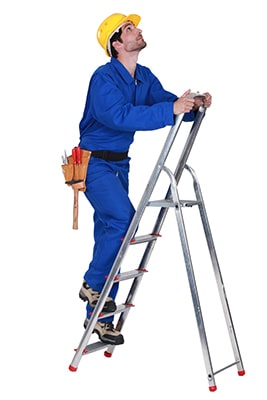Have you heard the news? March is Ladder Safety Month! That means it’s a good time to look at ladder safety at your company.
OSHA’s walking and working surface safety regulations include working from ladders. One of the most popular workplace tools in both construction and industry can often pose a safety risk when used incorrectly. According to OSHA, slips, trips, and falls continue to be the number one cause of workplace injuries, with almost 30% of workplace injuries attributed to them.
Many of these workplace accidents involve falls from ladders. And all these falls could and should have been prevented.

Here are a few OSHA regulations that must be followed in the workplace and should also be followed when working at home.

Ladders should have legible labels on the side rail that indicate the total weight load allowed and ladder classification, including the worker, tools, and materials allowed. And, that label must also indicate the safe working height. OSHA requires that these labels are in place and visible.
The most common safety error is overreaching. This can cause a step ladder to topple or an extension ladder to slide sideways along a surface. Injuries are often serious and sometimes fatal. Overreaching is considered moving a shoulder past the center line of the ladder.
Three points of contact must be maintained when climbing and working on a ladder. That means a combination of hands and feet. If a task requires both hands to be free, a scaffold, scissor lift, or other elevated platform should be implemented.
To maintain balance, it’s critical that the body is always pointed toward the ladder. Twisting, bending, and turning can disrupt that balance and cause a fall.
It’s never safe for more than one person to be on a ladder at one time. Not only does it disrupt the balance of the ladder and the people on it, but it also puts multiple people in danger.
When using a step ladder, all four feet must be on a flat, level surface. Never climb a step ladder that is leaning against a wall or support. Do not step higher than the third step from the top. Paint/tool trays that fold down on the back of a step ladder are not steps and not designed to support a person, nor are the rungs on the back of a step ladder.
Extension ladders come in many forms and have defined limits for their use. They should always extend three feet beyond the top ledge of the building. Often, two workers are required to set the ladder up properly. Ergonomic injuries often occur when ladders are caught by a gust of wind or snag on a tree branch. The base of the ladder should be one foot out from the wall for every four feet of elevation. This provides the safest angle, and most ladders have flats on the rungs that meet this angle. And again, the label should be in clear sight on the side rail.
When doing electrical work, use non-conductive ladders made of wood or fiberglass. Electrical shocks can cause or compound fall injuries and even cause death.
Tools and equipment should be brought up in a tool belt, not carried by hand. Additionally, you can use tethering devices for the safe use of portable power and hand tools at height. Not only does keeping your hands free prevent falls, but it will also help you avoid dropped-from-above accidents.
All ladders should be inspected for damage, missing labels, condition of non-skid pads, hardware, latches, ropes, pulleys, and cleats. Damaged ladders must be taken out of service until repairs are made.
Stored ladders of any kind must be tethered to a wall or support. Many injuries take place when a ladder is bumped and tips onto nearby workers.
Fixed vertical ladders require complete inspection on a regular basis depending on environmental and use conditions. OSHA regulations regarding the safety devices for these ladders have changed recently.
Even though many companies include ladder safety in their annual safety training program, people still use ladders unsafely. Safety training is an important element in any safety culture, reinforcing policies and procedures. It’s also important to frequently assess conditions at facilities and around work sites to ensure proper precautions are taken to avoid injuries.
I include ladder safety as a training module when I provide “Working at Height – Fall Protection” training courses for our customers as well as our own staff. Annual training is recommended as a reminder for all who use these common devices at work and at home. Contact us today.
